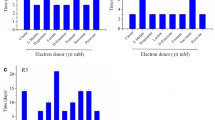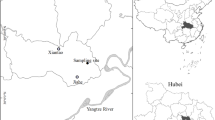Abstract
Previous studies show the importance of iron- and arsenate-reducing bacteria in mobilizing arsenic in groundwater. Here the authors present experimental evidence of arsenic mobilization in connection with bacterially mediated manganese reduction in groundwater affected by mining activities. Manganese-reducing Pseudomonas species were enriched, isolated and identified by 16S rRNA gene phylogeny from groundwater containing high co-dissolved arsenic (as AsIII) and manganese. Enrichment cultures dissolved synthetic birnessite and hausmannite efficiently, but Mn reduction by isolates was reduced at the upper range of environmental levels of dissolved AsIII. Results suggest either a self-limiting release of arsenic coupled to bacterial manganese reduction, in the absence of other electron donors like sulfide, or increased arsenic resistance conferred to Mn-reducing bacteria in consortia.





Similar content being viewed by others
References
Ahmann D, Krumholz LR, Hemond HF, Lovley DR, Morel FMM (1997) Microbial mobilization of arsenic from sediments of the Aberjona watershed. Environ Sci Technol 31:2923–2930
Aklujkar M, Coppi MV, Leang C, Kim B-C, Chavan MA, Perpetua LA, Giloteaux L, Liu A, Holmes D (2013) Proteins involved in electron transfer to Fe(III) and Mn(IV) oxides by Geobacter sulfurreducens. Microbiol 159:515–535. doi:10.1099/mic.0.064089-0
Altschul SF, Gish W, Miller W, Myers EW, Lipman DJ (1990) Basic local alignment search tool. J Mol Biol 215:403–410
Anawar HM, Akai J, Komaki K, Terao H, Yoshioka T, Ishizuka T, Safiullah S, Kato K (2003) Geochemical occurrence of arsenic in groundwater of Bangladesh: sources and mobilization processes. J Geochem Expl 77:109–131
Baïda N, Yazourh A, Singer E, Izard D (2002) Pseudomonas grimontii sp. nov. Int J Sys Evol Mic 52:1497–1503
Berg M, Trang PTK, Stengel C, Buschmann J, Viet PH, Dan NV, Giger W, Stüben D (2008) Hydrological and sedimentary controls leading to arsenic contamination of groundwater in the Hanoi area, Vietnam: the impact of iron-arsenic ratios, peat, river bank deposits, and excessive groundwater abstraction. Chem Geol 249:91–112
Borch T, Kretzschmar R, Kappler A, Van Cappellen P, Ginder-Vogel M, Voegelin A, Campbell K (2010) Biogeochemical redox processes and their impact on contaminant dynamics. Environ Sci Technol 44:15–23
Boyle RW, Jonasson IR (1973) The geochemistry of As and its use as an indicator element in geochemical prospecting. J Geochem Expl 2:251–256
Brutinel ED, Gralnick JA (2012) Shuttling happens: soluble flavin mediators of extracellular electron transfers in Shewanella. Appl Microbiol Biotechnol 93:41–48
Cai Y, Cabrera JC, Georgiadisa M, Jayachandran K (2002) Assessment of arsenic mobility in the soils of some golf courses in south Florida. Sci Total Environ 291:123–134
Caspi E, Tebo BM, Haygood MG (1998) c-Type cytochromes and manganese oxidation in Pseudomonas putida MnB1. Appl Environ Microbiol 64:3549–3555
Cerrato JM, Falkinham JO III, Dietrich AM, Knocke WR, McKinney CW, Pruden A (2010) Manganese-oxidizing and––reducing microorganisms isolated from bio-films in chlorinated drinking water systems. Water Res 44:3935–3945
Cummings DE, Caccavo F Jr, Fendorf S, Rosenzweig RF (1999) Arsenic mobilization by the dissimilatory Fe(III)-reducing bacterium Shewanella alga BrY. Environ Sci Technol 33:723–729
Di-Ruggiero J, Gounot A (1990) Microbial manganese reduction mediated by bacterial strains isolated from aquifer sediments. Microb Ecol 20:53–63
Dixit S, Hering JG (2003) Comparison of arsenic (V) and arsenic (III) sorption onto iron oxide minerals: implications for arsenic mobility. Environ Sci Technol 37:4182–4189
Duckworth OW, Sposito G (2007) Siderophore-promoted dissolution of synthetic and biogenic layer-type Mn oxides. Chem Geol 242:497–508
Ehrlich HL, Newman DK (2009) Geo-microbiology. CRC Press, Boca Raton, pp 348–351
Elomari M, Coroler L, Hoste B, Gillis M, Izard D, Leclerc H (1996) DNA relatedness among Pseudomonas strains isolated from natural mineral waters and proposal of Pseudomonas veronii sp. nov. Int J Sys Evol Mic 46:1138–1144
Fawcett SE, Jamieson HE (2011) The distinction between ore processing and post-depositional transformation on the speciation of arsenic and antimony in mine waste and sediment. Chem Geol 283:109–118
Fendorf S, Michael HA, van Geen A (2010) Spatial and temporal variations of groundwater arsenic in south and south east Asia. Science 328:1123–1127
Gandy CJ, Smith JWN, Jarvis AP (2007) Attenuation of mining-derived pollutants in the hyporheic zone: a review. Sci Total Environ 373:435–446
Garcia-Sanchez A, Alvarez-Ayuso E (2003) Arsenic in soils and waters and its relation to geology and mining activities (Salamanca Province, Spain). J Geochem Expl 80:69–79
He YT, Hering JG (2009) Enhancement of arsenic(III) sequestration by manganese oxides in the presence of iron(II). Water Air Soil Poll 203:359–368
Hoffman F (1993) Groundwater remediation using “smart pump and treat”. Ground Water 31:98–106
Islam FS, Gault AG, Boothman C, Polya DA, Charnock JM, Chatterjee D, Lloyd JR (2004) Role of metal-reducing bacteria in arsenic release from Bengal delta sediments. Nature 430:68–71
Joshi DN, Patel JS, Flora SJS, Kalia K (2008) Arsenic accumulation by Pseudomonas stutzeri and its response to some thiol chelators. Environ Health Prev Med 13:257–263
Karori S, Clifford D, Ghurye G, Samanta G (2006) Development of a field speciation method for inorganic arsenic species in groundwater. J Amer Water Works Assoc 98:128–141
Kent DB, Fox PM (2004) The influence of groundwater chemistry on arsenic concentrations and speciation in a quartz sand and gravel aquifer. Geochem Trans. doi:10.1063/1.1738211
Korte NE, Fernando Q (1991) A review of arsenic(III) in groundwater. Crit Rev Env Contr 21:1–39
Kumar AR, Riyazuddin P (2010) Preservation of inorganic arsenic species in environmental water samples for reliable speciation analysis. Tren Anal Chem 29:1212–1223
Lee KY, Kim K-W, Kim SO (2010) Geochemical and microbial effects on the mobilization of arsenic in mine tailing soils. Environ Geochem Health 32:31–44
Lin H, Szeinbaum NH, DiChristina TJ, Taillefert M (2012) Microbial Mn(IV) reduction requires an initial one-electron reductive dissolution step. Geochim Cosmochim Acta 99:179–192
Lovley DR (1991) Dissimilatory Fe(III) and Mn(IV) reduction. Microbiol Rev 55:259–287
Lovley DR, Phillips EJP (1988) Novel mode of microbial energy metabolism: organic carbon oxidation coupled to dissimilatory reduction of iron or manganese. Appl Environ Microbiol 54:1472–1480
Lovley DR, Holmes DE, Nevin KP (2004) Dissimilatory Fe(III) and Mn(IV) reduction. Adv Microb Physiol 49:219–286
Mackay DM, Cherry JA (1989) Groundwater contamination: pump and treat remediation. Environ Sci Technol 23:630–636
Manning BA, Fendorf SE, Bostick B, Suarez DL (2002) Arsenic(III) oxidation and arsenic(V) adsorption reactions on synthetic birnessite. Environ Sci Technol 36:976–981
Miller J, Wilson CJL (2002) The Magdala Lode system, Stawell, south eastern Australia; structural style and relationship to gold mineralization across the Western Lachlan fold belt. Econ Geol 97:325–349
Morrison SJ, Metzler DR, Dwyer BP (2002) Removal of As, Mn, Mo, Se, U, V and Zn from groundwater by zero-valent iron in a passive treatment cell: reaction progress modelling. J Contam Hydrol 56:99–116
Mukherjee A, Sengupta MK, Hossain MA, Ahamed S, Das B, Nayak B, Lodh D, Rahman MM, Chakraborti D (2006) Arsenic contamination in groundwater: a global perspective with emphasis on the Asian scenario. J Health Pop Nut 24:142–163
Nealson KH, Myers CR (1992) Microbial reduction of manganese and iron: new approaches to carbon cycling. Appl Environ Microbiol 58:439–443
Nesbitt HW, Canning GW, Bancroft GM (1998) XPS study of reductive dissolution of 7Å-birnessite by H3AsO3, with constraints on reaction mechanism. Geochim Cosmochim Acta 62:2097–2110
Noble RRP, Hough RM, Watkins RT (2010) Enrichment and exposure assessment of As, Cr and Pb of the soils in the vicinity of Stawell, Victoria, Australia. Environ Geochem Health 3:193–205
Pak KR, Lim O-Y, Lee H-K, Choi S-C (2002) Aerobic reduction of manganese oxide by Salmonella sp. strain MR4. Biotechnol Lett 24:1181–1184
Paktunc D, Foster A, Heald S, Laflamme G (2004) Speciation and characterization of arsenic in gold ores and cyanidation tailings using X-ray absorption spectroscopy. Geochim Cosmochim Acta 68:969–983
Prithivirajsingh S, Mishra SK, Mahadevan A (2001) Detection and analysis of chromosomal arsenic resistance in pseudomonas fluorescens strain MSP3. Biochem Biophys Res Comm 280:1393–1401
Rao CRM (1994) Cold decomposition procedure for the spectrophotometric determination of manganese in rocks, ores and minerals. Anal Chim Acta 291:137–140
Rose AW, Hawkas HE, Webb JS (1979) Geochemistry in mineral exploration. Academic Press, London
Rosson RA, Nealson KH (1982) Manganese binding and oxidation by spores of a marine Bacillus. J Bacteriol 151:1027–1034
Smedley PL, Kinniburgh DG (2002) A review of the source, behaviour and distribution of arsenic in natural waters. Appl Geochem 17:517–568
Stollenwerk KG (2003) Geochemical processes controlling transport of arsenic in groundwater: a review of adsorption. Arsenic in Ground Water: geochemistry and occurrence. Springer, USA. doi:10.1007/b101867
Sutton NB, van der Kraan GM, van Loosdrecht MCM, Muyzer G, Bruining J, Schotting RJ (2009) Characterization of geochemical constituents and bacterial populations associated with As mobilization in deep and shallow tube wells in Bangladesh. Water Res 43:1720–1730
Tebo BM, Clement BG, Dick GJ (2007) Bio transformations of manganese. In: Hurst CJ, Crawford RL, Garland JL, Lipson DA, Mills AL, Stetzenbach LD (eds) Manual of environmental microbiology, 3rd edn. ASM Press, Washington DC, pp 1223–1238
Tufano KJ, Reyes C, Saltikov CW, Fendorf S (2008) Reductive processes controlling arsenic retention: revealing the relative importance of iron and arsenic reduction. Environ Sci Technol 42:8283–8289
URS Corp Australia Pvt Ltd (2010) Groundwater management plan Stawell Gold Mines TSF no. 2. June 25, 2010. Ref no 43271133/GMP TSF2_V5
Villaescusa I, Bollinger JC (2008) Arsenic in drinking water: sources, occurrence and health effects (A review). Rev Environ Sci Biotechnol 7:307–323
Villalobos M, Toner B, Bargar J, Sposito G (2003) Characterization of the manganese oxide produced by Pseudomonas putida strain MnB1. Geochim Cosmochim Acta 67:2649–2662
Wang S, Mulligan C (2006) Natural attenuation processes for remediation of arsenic contaminated soils and groundwater. J Haz Mater 138:459–470
Wang Y, Kern SE, Newman DK (2010) Endogenous phenazine antibiotics promote anaerobic survival of Pseudomonas aeruginosa via extracellular electron transfer. J Bacteriol 192:365–369
Willman CE, Korsch RJ, Moore DH, Cayley RA, Lisitsin VA, Rawling TJ, Morand VJ, O’Shea PJ (2010) Crustal-scale fluid pathways and source rocks in the Victorian gold province, Australia: insights from deep seismic reflection profiles. Econ Geol 105:895–915
Ying SC, Kocar BD, Fendorf S (2012) Oxidation and competitive retention of arsenic between iron- and manganese oxides. Geochim Cosmochim Acta 96:294–303
Zouboulis AI, Katsoyiannis IA (2005) Recent advances in the bioremediation of arsenic-contaminated ground waters. Environ Int 31:213–219
Acknowledgments
The authors thank Crocodile Gold Corp. (formerly Northgate Minerals Corp.), Stawell, Victoria, for access to historical data and fieldwork support at the Stawell gold mine. We thank Dr. Helen Billman–Jacobe of the University of Melbourne for a culture of Pseudomonas aeruginosa used as a control in this study. The authors thank Ms. Emily Hepburn for field- and lab-work support, and Prof. John Webb of LaTrobe University for XRD data. This research received financial support from Northgate Minerals Corp. to J.W.M. and A.S.H., a Strategic Research Initiative grant from the University of Melbourne to J.W.M., and a research scholarship from the School of Earth Sciences at the University of Melbourne to A.S.H.
Author information
Authors and Affiliations
Corresponding author
Additional information
A. S. Horvath and L. V. Garrick have contributed equally to this work.
Electronic supplementary material
Below is the link to the electronic supplementary material.
12665_2013_2809_MOESM1_ESM.pdf
X-ray diffraction spectrum of synthetic Mn-oxide used in microbial Mn-reduction culturing experiments. Pattern shows the presence of both birnessite and hausmannite phases. 1 (PDF 39 kb)
Rights and permissions
About this article
Cite this article
Horvath, A.S., Garrick, L.V. & Moreau, J.W. Manganese-reducing Pseudomonas fluorescens-group bacteria control arsenic mobility in gold mining-contaminated groundwater. Environ Earth Sci 71, 4187–4198 (2014). https://doi.org/10.1007/s12665-013-2809-x
Received:
Accepted:
Published:
Issue Date:
DOI: https://doi.org/10.1007/s12665-013-2809-x




